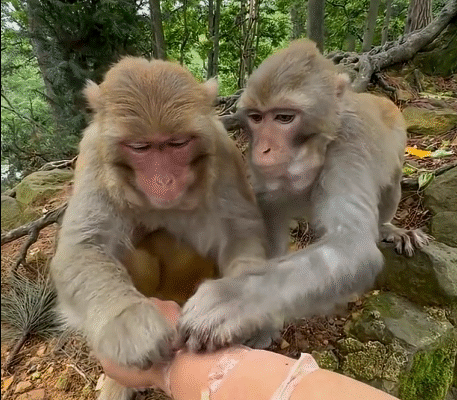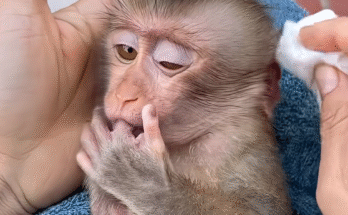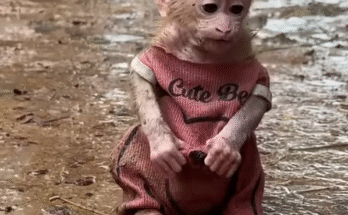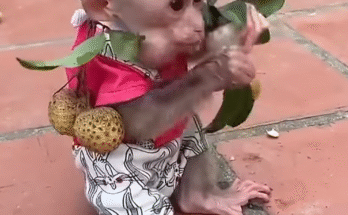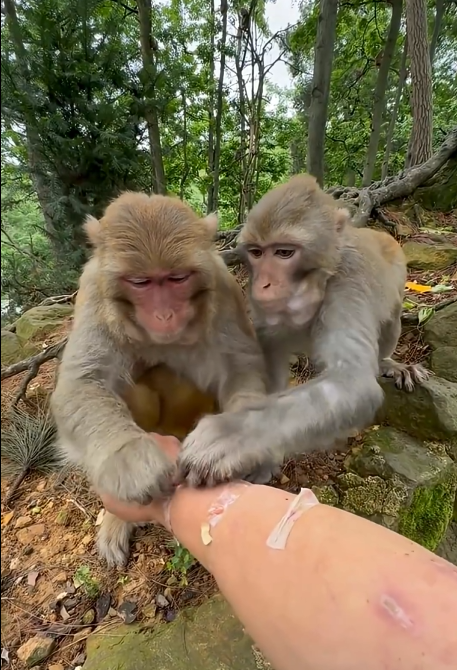
In the playful world of monkeys, few things spark as much mischief and hilarity as food, and when that food happens to be sticky peanuts, chaos is practically guaranteed. Monkeys are known for their curiosity, intelligence, and dexterity, but introduce a challenge like sticky peanuts, and suddenly their skills are tested in the most comedic ways. Observers have long marveled at these slapstick encounters, where patience, cunning, and sheer clumsiness collide, creating unforgettable scenes that are both funny and fascinating. This article explores the hilarious dynamics of Monkeys vs Sticky Peanuts — from clever strategies to unexpected disasters — revealing just how entertaining our primate friends can be when snacks get tricky.
The Attraction of Sticky Peanuts
Peanuts are a favorite treat among many monkey species. They are small, nutritious, and easy to carry, making them ideal for foraging. However, when peanuts are sticky — coated in syrup, honey, or resin — they present a unique challenge: the more the monkeys try to handle them, the stickier and more awkward they become.
- Sensory Temptation: Sticky peanuts smell irresistible, drawing monkeys’ attention instantly. Their noses twitch, eyes widen, and hands reach eagerly for the treat.
- Fine Motor Challenge: Handling sticky peanuts requires dexterity and patience. The sticky coating tests even the most skilled primates, leading to fumbles, dropped snacks, and hilarious improvisation.
- Social Interest: Sticky peanuts often attract a crowd. Monkeys observing others struggle with these treats can’t resist joining in, creating a spectacle of competitive chaos.
Hilarious Tactics Monkeys Use
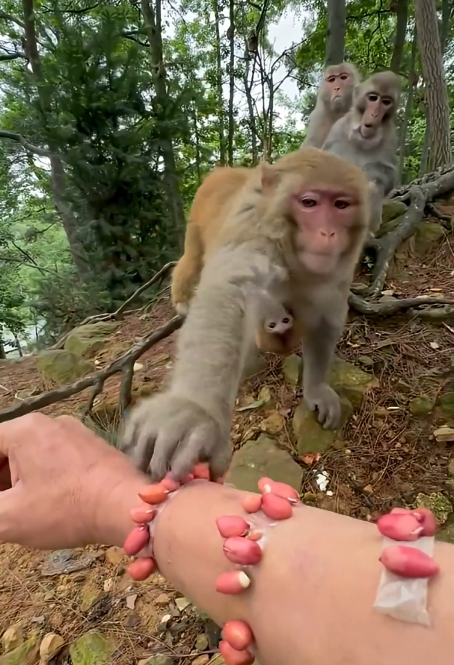
Monkeys approach sticky peanuts with a combination of intelligence and improvisation. Their strategies range from clever to utterly absurd, often resulting in unexpected outcomes:
- Finger Licking Frenzy: The most common approach involves using fingers to scoop and lick the sticky coating. What starts as careful handling quickly turns into a frenzy of fingers stuck to peanuts, hands smeared with syrup, and frantic attempts to free themselves.
- Fur Cleaning Failures: Sometimes monkeys try to transfer the sticky peanuts to nearby branches, tree trunks, or even their fur. The result is a hilarious mess, as peanuts get stuck in fur or clothing-like coats, requiring frantic grooming to remove the goo.
- Two-Handed Tug-of-War: Sticky peanuts often require both hands to maneuver. Monkeys may fumble, drop, or even toss the peanut unintentionally, prompting frantic chases or negotiations with other monkeys in the troop.
- Cooperative (and Competitive) Strategies: Some monkeys attempt teamwork, passing peanuts to others to manage the stickiness. Others turn competitive, snatching sticky peanuts mid-struggle, escalating the chaos and providing endless entertainment.
- Dropping and Regaining: Sticky peanuts are notorious for slipping from hands. Monkeys often engage in acrobatic efforts to retrieve them, leaping, twisting, or balancing precariously — all with exaggerated expressions of determination and sometimes comical frustration.
Classic Sticky Peanut Scenarios
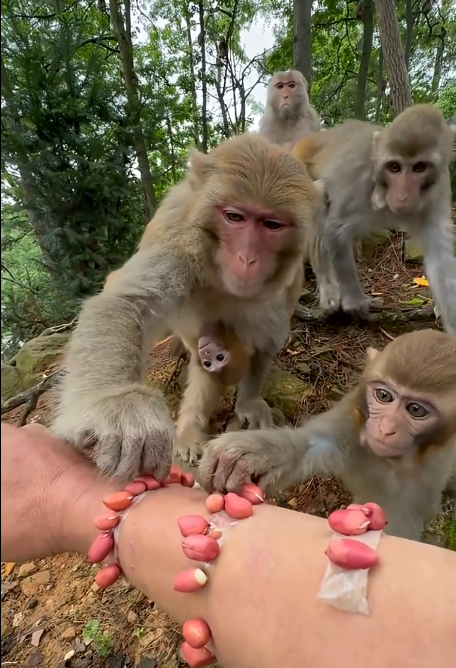
Over time, certain scenarios have become legendary among wildlife observers and online viewers:
- The Peanut Avalanche: One monkey attempts to handle multiple sticky peanuts at once, only to have them clump together and fall in a messy cascade. The scramble to recover the treats is chaotic, with limbs, tails, and expressions all contributing to the hilarity.
- The Solo Struggle: A particularly stubborn peanut sticks to a monkey’s hand or nose. The monkey tries every possible solution — rubbing it on a tree, licking fur, or using another hand — all while making dramatic faces of exasperation.
- The Peanut Heist: Observing monkeys often exploit the struggle of their peers. One monkey struggling with a sticky peanut may become the target of a stealthy snatch from another monkey, resulting in a chase that looks more like a comedy sketch than a serious competition.
- The Floor Disaster: When sticky peanuts fall to the ground, monkeys hesitate. Some gingerly try to pick them up, while others slap, stomp, or rub them to loosen the coating, often ending with even more mess — sticky paws, dirty faces, and laughter-worthy expressions.
The Comedic Appeal
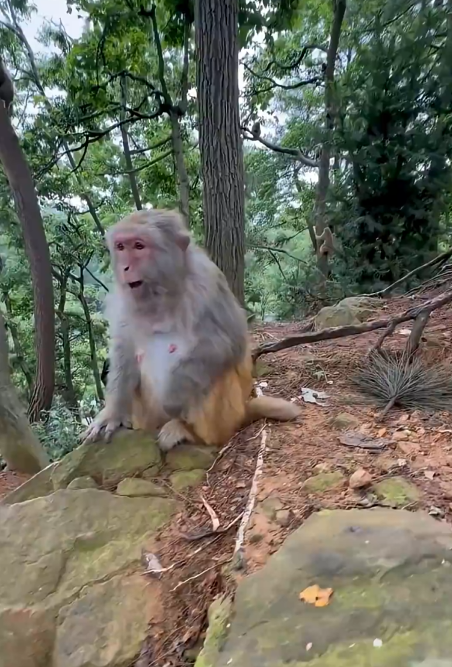
The conflict between monkeys and sticky peanuts is universally funny because it combines intelligence, frustration, and physical comedy:
- Expressive Faces: Monkeys are highly expressive. Watching their wide eyes, open mouths, and furrowed brows during sticky peanut mishaps creates a natural comedy that is instantly relatable.
- Unexpected Outcomes: Despite their dexterity, monkeys often fail spectacularly when dealing with stickiness. A clever solution can quickly backfire, creating a chain of comedic events.
- Relatability: Anyone who has struggled with sticky food — peanut butter on toast, caramel, or candy — can empathize with the monkeys. Their frustration, ingenuity, and eventual surrender to messiness feel familiar, making the scenes even funnier.
- Social Interaction: These incidents are rarely solitary. The troop’s reactions, including laughter-like vocalizations, competitive snatching, or sympathetic assistance, add layers of humor and social complexity to the scenario.
Lessons from Monkeys vs Sticky Peanuts
Beyond the comedy, these encounters offer insights into primate intelligence, problem-solving, and social behavior:
- Cognitive Flexibility: Monkeys demonstrate problem-solving skills, trying multiple strategies to handle sticky peanuts. This highlights their capacity for adaptive thinking and experimentation.
- Persistence and Resilience: Despite repeated failures, monkeys persist, showing determination and resilience. Even in frustration, they continue exploring solutions — a lesson in perseverance.
- Social Learning: Younger monkeys learn by observation, imitating strategies of older, more experienced monkeys. Mistakes become educational, both for individuals and the troop.
- Play and Enrichment: Sticky peanuts provide mental stimulation and enrichment. The challenge itself is entertaining and beneficial, encouraging engagement, creativity, and dexterity.
Sticky Peanut Showdowns: Captured on Camera
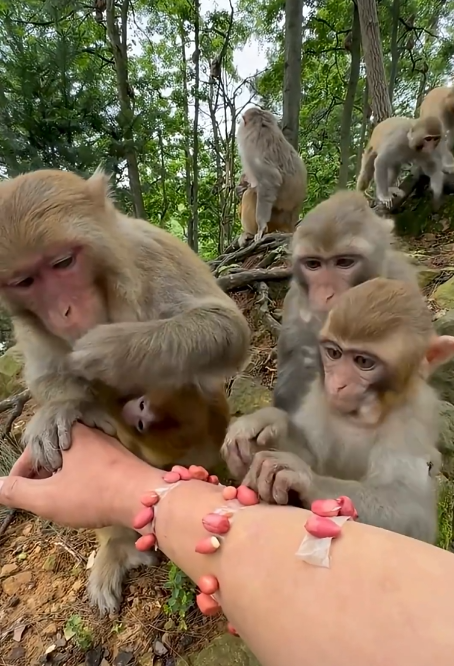
In recent years, viral videos of monkeys versus sticky peanuts have captivated audiences worldwide. Some iconic moments include:
- The Peanut Flip: A monkey flips a peanut with one hand, only to have it stick to another limb mid-air, creating a slow-motion comedy of errors.
- The Group Mess: A troop gathers around a spilled pile of sticky peanuts, each attempting a different approach, resulting in a messy, hilarious battle that looks choreographed for slapstick perfection.
- The Determined Duo: Two monkeys try to share a sticky peanut, pulling it from opposite ends, while expressions of determination and frustration make the scene resemble a competitive sport.
These videos not only entertain but also showcase monkey ingenuity, social bonds, and the universal appeal of messy, funny struggles.
Conclusion
The epic battle between monkeys and sticky peanuts is more than a series of comical mishaps; it is a testament to primate intelligence, social dynamics, and playful behavior. Whether they are struggling alone, competing with peers, or improvising clever solutions, monkeys bring humor, creativity, and emotion to every sticky encounter.
From the exaggerated expressions of exasperation to the chaotic chases across branches, sticky peanuts reveal the perfect combination of intelligence and silliness that makes primates endlessly entertaining. Watching monkeys versus sticky peanuts is not just about observing animals; it’s about witnessing the universal truths of curiosity, frustration, ingenuity, and joy.
Ultimately, these sticky peanut skirmishes remind us that even in the animal kingdom, life is full of challenges, messes, and hilarity — and sometimes, the best solution is to embrace the chaos, lick a sticky hand, and keep going. 🥜🤣🐒
